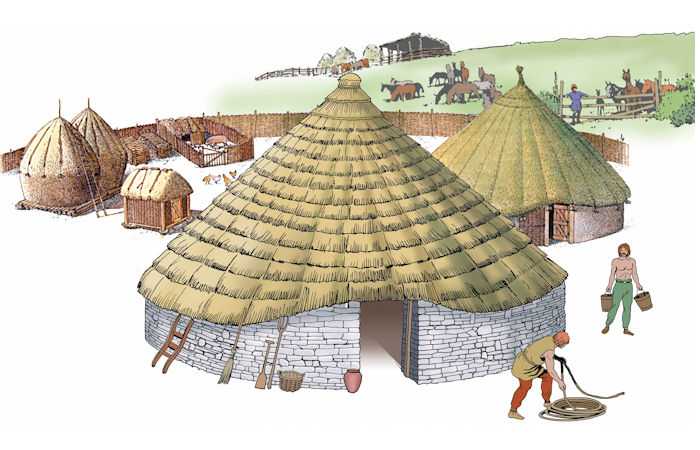Din Lligwy: Prehistoric Celtic Settlement Of Anglesey, Wales
A. Sutherland - AncientPages.com - The prehistoric ruins of the Din Lligwy settlement have a long history spanning three eras.
House foundations at Din Lligwy hut circle, Anglesey, August 2, 2004. Image credit: Velela - CC0 1.0 -Public Domain
It is a fascinating place on the eastern coast of Anglesey, Wales, United Kingdom, which has experienced more than 5000 years of human activity.
The Din Lligwy Ancient Village (also known as the Din Lligwy Hut Group) represents a set of structures, including a Neolithic burial chamber, an Iron Age village, and an old, long-abandoned church. It was built by the native population of Anglesey during the latter part of the Roman occupation of Wales. But the origin of the settlement may well go back to the Iron Age.
Din Lligwy Burial Chamber consists of a circle of eight upright stones of differing shapes, all supporting a massive capstone, 5.9m by 5.2m and 1.1m thick. The enormous capstone weighs approximately 25 tons, while the chamber has a height of about 2 meters. An earthen mound would have covered initially Lligwy. If such a cairn once covered this chambered tomb, no trace remains.
This ancient chamber, dated to c. 3000 BC, was excavated by archaeologists in 1908/9. They discovered the bones of men, women, and children, animal bones, flint implements, shells, pottery, and a bone pin.
Lligwy Burial Chamber. Image credit: Kate Heath - Flickr - CC BY 2.0
It is worth noting that even earlier (1905-07), excavations revealed hundreds of Roman potsherds dated back to the 3rd and 4th centuries AD, many repaired with iron clamps, pottery, and coins.
People focused on ironworking, smithing, and probably smelting, supported by smelting hearths and iron slag in some of the building remains. The settlement includes a series of well-preserved stone huts within a stone-walled enclosure.
Two rectangular huts contained six smelting hearths. One well-preserved Din Lligwy hut circle - probably dated from the 2nd to the 4th centuries AD – was occupied up to the Romano-British time.
Credit: Adobe Stock - Massimo Todaro
Two different settlements once existed in the area. The grooved ware dates to the Neolithic period and represents the British Neolithic pottery style.
Another one is beaker ware from the early Bronze Age. However, the presence of grooved ware and beaker pottery would suggest that this tomb was used during the Neolithic and later, during the early Bronze Age.
At first, Iron Age Britons probably lived in the area. Excavations on the site revealed that the round structures were likely houses, and the rectangular ones were barns or workshops. Later, these people were influenced mainly by the lifestyle of the invading Romans. The settlement is one of several that existed in the Lligwy Valley.
It is believed that two rectangular huts contained six smelting hearths. At first, Iron Age Britons probably lived in roundhouses; later, these people were influenced mainly by the lifestyle of the invading Romans. The settlement is one of several in the Lligwy Valley.
Times when the Vikings invaded North Wales were troublesome.
Historical records show that a series of terrifying attacks by Viking invaders on the coasts of Britain, France, and Ireland occurred in the last decade of the 8th century.
However, archaeological evidence shows these invaders may not have been as devastating as records claim.
The first recorded raid on Wales occurred in 852, and later, further attacks by Vikings on Anglesey and Gwynedd from 854 onwards. Rhodri Mawr, the ruler of Gwynedd (844-78), led resistance to these early destructive attacks, killing the Danish leader Gorm in 855.
Rhodri Mawr, King of Wales/King of the Britons. Credit: Public Domain
In the meantime, Vikings - after being driven out of Dublin - came to Anglesey in 903. Irish and Welsh records said they failed to establish in Wales, so they decided to sail to Chester. But again, in 918, Anglesey was ravaged by Vikings.
Frequent attacks occurred on the island during the second half of the 10th century; Olaf of Dublin built a castle known as 'Olaf's Castle' or 'Castell Bon y Dom' in the year 1000.
This one-sided historical record of Vikings terrorizing the land has now been transformed by archaeology. Viking contact was sometimes hostile and brutal; however, in some areas, the Vikings rapidly settled as peaceful farmers. Archaeological excavations have provided evidence of these people as colonizers, skilled craftsmen, and merchants.
The nature of Viking settlement in Wales remains one of the mysteries of early medieval archaeology, none more so than on Anglesey. Vikings are firmly and undoubtedly historically associated with the Isle of Man, Dublin, Chester, and the Wirral. Geographically, these places are also linked with the waters of Anglesey. Therefore, the activities in this area left their mark on Anglesey's history.
Written by – A. Sutherland AncientPages.com Senior Staff Writer
Updated on Mar 1, 2024
Copyright © AncientPages.com All rights reserved. This material may not be published, broadcast, rewritten or redistributed in whole or part without the express written permission of AncientPages.com
Expand for referencesReferences:
More From Ancient Pages
-
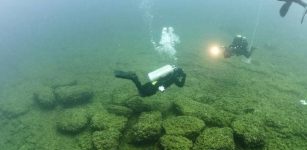 Traces Of A 9,000-Year-Old Lost Unknown Civilization Discovered In Lake Huron, Michigan
Civilizations | Aug 11, 2014
Traces Of A 9,000-Year-Old Lost Unknown Civilization Discovered In Lake Huron, Michigan
Civilizations | Aug 11, 2014 -
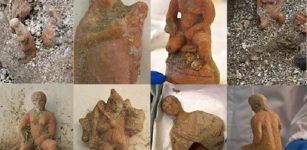 13 Ancient Terracotta Figurines Associated With Cybele And Attis Unearthed In Pompeii
Archaeology | Dec 28, 2023
13 Ancient Terracotta Figurines Associated With Cybele And Attis Unearthed In Pompeii
Archaeology | Dec 28, 2023 -
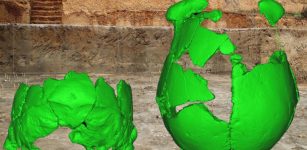 Partial Skull Fossils Found In China Could Be A New Species -‘A Kind Of Unknown Or New Archaic Human’, Researcher Says
Archaeology | Mar 6, 2017
Partial Skull Fossils Found In China Could Be A New Species -‘A Kind Of Unknown Or New Archaic Human’, Researcher Says
Archaeology | Mar 6, 2017 -
 Trident: Powerful Religious Symbol Found In Many Ancient Cultures
Ancient Symbols | Dec 4, 2019
Trident: Powerful Religious Symbol Found In Many Ancient Cultures
Ancient Symbols | Dec 4, 2019 -
 Vimanas – Flying Machines Soaring Through Ancient Sky Of India
Featured Stories | May 27, 2014
Vimanas – Flying Machines Soaring Through Ancient Sky Of India
Featured Stories | May 27, 2014 -
 Mystery How Humans Lost Their Body Hair Solved By Scientists
Archaeology | Jan 4, 2023
Mystery How Humans Lost Their Body Hair Solved By Scientists
Archaeology | Jan 4, 2023 -
 Handshaking Is An Ancient Tradition – When, Where And Why Did We Start To Clasp Hands?
Ancient History Facts | Aug 30, 2019
Handshaking Is An Ancient Tradition – When, Where And Why Did We Start To Clasp Hands?
Ancient History Facts | Aug 30, 2019 -
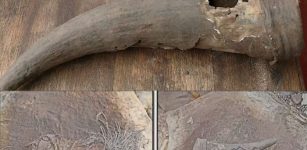 Unusual Parcel With 500-Year-Old Horn Container Discovered In South Africa Sheds Light On Pre-Colonial Khoisan Medicines
Featured Stories | Feb 15, 2023
Unusual Parcel With 500-Year-Old Horn Container Discovered In South Africa Sheds Light On Pre-Colonial Khoisan Medicines
Featured Stories | Feb 15, 2023 -
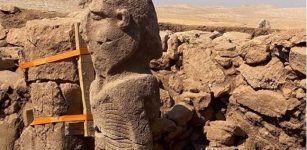 World’s Oldest Human Statue Discovered At Karahan Tepe, Turkey
Archaeology | Oct 30, 2023
World’s Oldest Human Statue Discovered At Karahan Tepe, Turkey
Archaeology | Oct 30, 2023 -
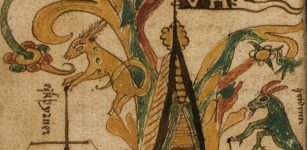 Eikthyrnir – Mythical Male Deer And Heidrun She-Goat Stand On The Top Of Valhalla
Featured Stories | Feb 11, 2019
Eikthyrnir – Mythical Male Deer And Heidrun She-Goat Stand On The Top Of Valhalla
Featured Stories | Feb 11, 2019 -
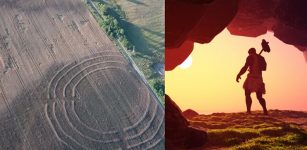 Giant 7,000-Year-Old Astronomical Calendar Discovered In Poland?
Archaeology | Dec 22, 2017
Giant 7,000-Year-Old Astronomical Calendar Discovered In Poland?
Archaeology | Dec 22, 2017 -
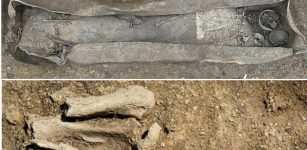 Ancient Necropolis With Lead Coffins Sheds Light On Early Christian Funeral Practices
Archaeology | Jul 13, 2020
Ancient Necropolis With Lead Coffins Sheds Light On Early Christian Funeral Practices
Archaeology | Jul 13, 2020 -
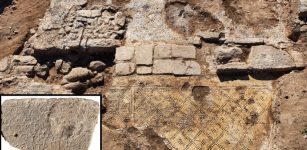 1,500-Year-Old Inscription ‘Christ, Born Of Mary’ Engraved On Magnificent Building Discovered In Israel
Archaeology | Jan 21, 2021
1,500-Year-Old Inscription ‘Christ, Born Of Mary’ Engraved On Magnificent Building Discovered In Israel
Archaeology | Jan 21, 2021 -
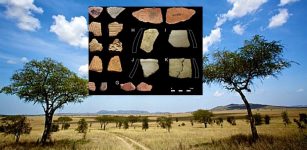 Evidence For Milk, Meat, And Plants In Prehistoric Kenya And Tanzania
Archaeology | Apr 15, 2020
Evidence For Milk, Meat, And Plants In Prehistoric Kenya And Tanzania
Archaeology | Apr 15, 2020 -
 Humans’ Oldest Jawed Ancestor Is A 439-Million-Year-Old Spiky Shark – Surprising Discovery Shows
Archaeology | Sep 29, 2022
Humans’ Oldest Jawed Ancestor Is A 439-Million-Year-Old Spiky Shark – Surprising Discovery Shows
Archaeology | Sep 29, 2022 -
 World’s Oldest Dictionaries Are 4,500-Year-Old Cuneiform Tablets Discovered In Ebla
Ancient History Facts | Aug 19, 2016
World’s Oldest Dictionaries Are 4,500-Year-Old Cuneiform Tablets Discovered In Ebla
Ancient History Facts | Aug 19, 2016 -
 Lofn ‘Matchmaker’ – Norse Goddess Of Forbidden Marriages Of People Who Wish To Be Loved And Search For Partners
Featured Stories | Mar 25, 2021
Lofn ‘Matchmaker’ – Norse Goddess Of Forbidden Marriages Of People Who Wish To Be Loved And Search For Partners
Featured Stories | Mar 25, 2021 -
 What Happened To The Ancient Tribe That Entered A Secret Underground World And Never Came Back?
Featured Stories | Feb 1, 2021
What Happened To The Ancient Tribe That Entered A Secret Underground World And Never Came Back?
Featured Stories | Feb 1, 2021 -
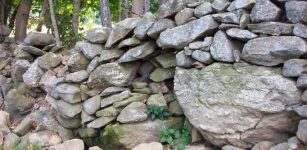 New England’s Abandoned Stone Walls Deserve A Science Of Their Own
Featured Stories | Jan 5, 2024
New England’s Abandoned Stone Walls Deserve A Science Of Their Own
Featured Stories | Jan 5, 2024 -
 On This Day In History: Captain James Cook Spotted The East Coast Of Australia – On Apr 19, 1770
News | Apr 19, 2016
On This Day In History: Captain James Cook Spotted The East Coast Of Australia – On Apr 19, 1770
News | Apr 19, 2016



